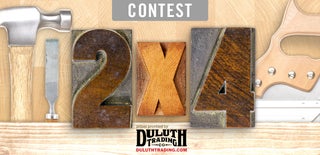Introduction: Student Standing Desk
As a teacher, I follow a number of education blogs and posts about innovative classroom practices. One that has recently caught my attention is the idea of a standing desk for students.
I have been using a standing desk in my classroom and in the office. The desk is not much more than a glorified table topper that allows me to stand while doing my "desk-work".
The benefits of standing desks have been well documented for both the office and more recently for students. They sit ALOT, and giving them the opportunity to stand is in their best interest - burn more calories, become more engaged in the lesson, stimulate parts of the brain that become dormant while sitting for a class period.
To purchase a standing desk, the price can run in the $100's. I saw a DIY desk on the Mint Design Blog:
http://www.mintdesignblog.com/2012/08/diy-standing...
Feeling inspired, my son and I set out to build one ourselves using 2"x4"'s, sawhorse brackets, and a piece of dry-erase board paneling.
Step 1: Step 1: Shopping List, Cut List, and Assembly
Shopping List:
4’ x 8’ sheet of dry-erase panel board
1 set of saw-horse brackets
4 - 2” x 4” x 8’ studs
screws/nails (2” or longer)
Cut List:
dry-erase panel board = 16” x 24” (I asked the staff at Lowes to cut the original panel into 12 panels measuring 24” x 16”; you only need one panel per desk, so save the other 11 panels to make more desks!)
studs = 2 @ 24”; 3 @ 12 ⅝” (these form the desktop); 2 @ 39 ¾”; 2 @ 24” (these form the legs and can be adjusted for the desired height - I am 6’ tall)
Assembly:
1. Lay out the two 24” studs and 3 12 ⅝” studs in the layout shown in the image above (not drawn to scale).
2. In addition to screwing the studs together, I also used wood glue on the joints.
3. Fasten the dry-erase panel to the top of the box; (use glue or screws, depending on whether or not you want a smooth top).
4. Assemble the legs using the sawhorse brackets (follow the directions on the packaging). Cut the legs and feet to achieve the desired height; the recommended total height is equal to the distance from your elbow to the floor.
5. Attach the legs to the center stud in the desktop and attach the feet as shown in the images.
6. Add paint or stain if desired.
Step 2: Final Thoughts:
The work surface is large enough to accommodate a Chromebook/laptop and student work papers. By using dry-erase paneling, it gives the student the freedom to use that work surface as well.
The students are anxiously awaiting their turn to test the desks out. As of this writing, I only made two desks. I think I will need to make more to meet the demand.
Total cost for one desk, about $20.00!
With future desks that I make, I will take more care with the cuts and make a more finished project (sanding, sinking/filling the screw heads, painting, etc).
Thanks for checking out my project!
Step 3: UPDATE
When I published the Instructable, I only had two desks in my room. The response was very positive. After students used the desk for a full period, they got to sign the desk. After using the desk, each student said the experience was positive and said they would use it again.
As seen in the second picture, I did add a piece of 2x4 between the feet. It seems to stabilize the legs and it also acts like a foot rest.
In the third picture, I show that I added a hook to the center 2x4 for a place to hang a backpack/purse. I also added a 3 1/2" piece of vinyl J-channel molding which acts as a whiteboard marker clip.
So because the demand was greater than the supply, I built a total of 6 desks. I have 20-25 students per class. Students can still sit if they wish - I have enough desks for that. I don't see the room becoming all standing desks. But this gives me and the students flexibility and choice.
Thanks.

Participated in the
2x4 Contest













